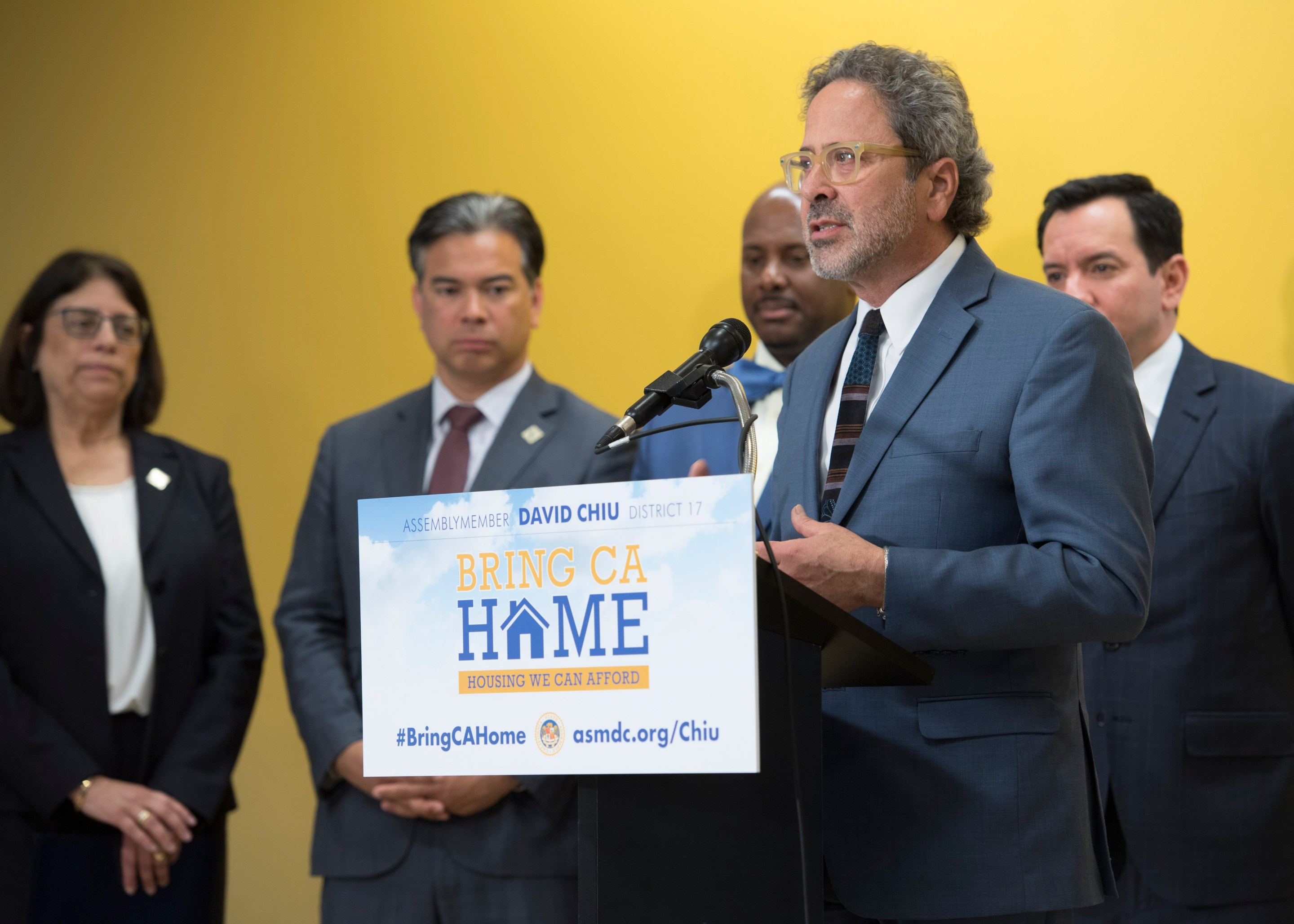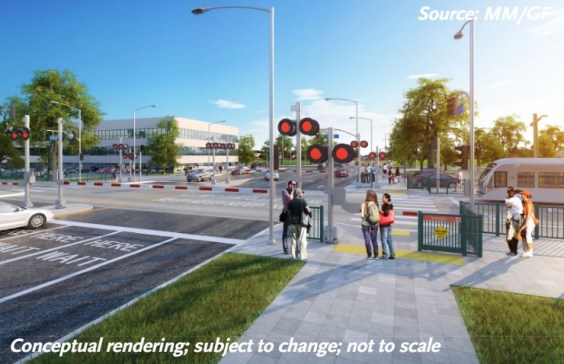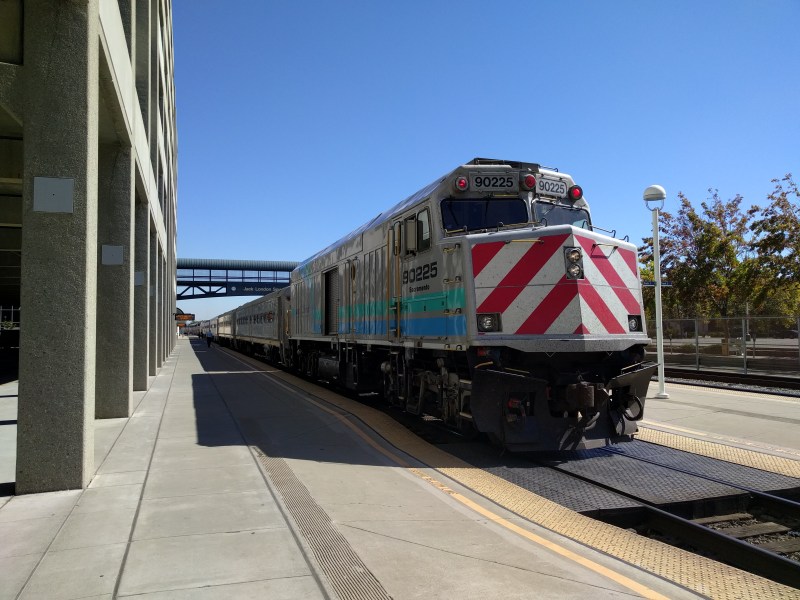A group of California Assemblymembers, including Speaker Anthony Rendon (D-Paramount), gathered yesterday for a press conference to continue to the beat the drum for immediate and long-term action to address the state’s dire housing crisis.
The nine lawmakers, including Assemblymember David Chiu (D-San Francisco) and Assemblymember Richard Bloom (D-Santa Monica), were joined by Tameeka Knox, a housing advocate and a formerly homeless person currently living in supportive affordable housing, to call for a dedicated state funding source for affordable housing as well as state legislative action to reduce barriers to housing growth and protect renters from displacement. A full video of the conference is available here.
“We have a housing crisis and we need to act now,” Chiu said Monday. “It is unconscionable that in the sixth largest economy in the world, we have 1.7 million households that lack access to affordable housing, and that includes 700,000 children.”
In Sacramento, momentum is clearly building to address the housing crisis and Speaker Rendon's presence at Monday's conference seems to suggest that the legislative leadership is taking the housing crisis ever more seriously. Chiu noted that there are currently 130 bills pending in the state legislature that address housing and Monday's conference was the second in as many months Chiu has organized to drive home the message that Sacramento needs to take action to address the housing crisis.
Over the past two years, several reports have come out of Sacramento’s nonpartisan Legislative Analyst’s Office that have hammered home again and again that decades of cities actively suppressing housing growth is driving up rents and displacing low- and (increasingly) middle-income residents.
Chiu and the other lawmakers acknowledged that the housing crisis is going to take a multi-pronged approach that includes lowering barriers to new housing growth and establishing dedicated state funding for affordable housing.
“Like transportation, we need to put our money where our mouth is. We finally need a permanent source of funding for affordable housing,” Chiu said, referring to the recent (and albeit narrow) victory lawmakers had in passing SB 1, which raised the state gas tax to fund transportation infrastructure.
Assembly Speaker Anthony Rendon noted that the Trump administration’s enthusiasm for cutting social welfare programs made state funding for housing an even more urgent need.
“It’s estimated that California needs 180,000 units of new housing every year for the next 10 years to meet its demand. But production has remained at less than 100,000 units a year for the past eight years. Now the Trump administration is proposing to make this crisis even worse,” Rendon said, noting that California stands to lose some $500 million in rental assistance for lower-income residents as a result of proposed budget cuts for the federal department of Housing and Urban Development (HUD).
“Funding alone won’t solve the problem,” Rendon added. He noted that there is real need for regulatory reform that would reduce barriers to infill housing as well as increase incentives for developers to build affordable housing.
Governor Jerry Brown has made it very clear that the fate of any state affordable housing funding is inextricably tied to regulatory reform.
The Governor’s proposed budget, released in January this year, did not include any new funding sources for affordable housing precisely because of the onerous zoning laws and other restrictions have made new housing construction too difficult and expensive:
"The Administration is committed to working with the Legislature on the development of a legislative package to further address the state’s housing shortage and affordability pressures. Such a package should include additional reforms and any new funding should not rely on the General Fund [...] Because it is counterproductive to develop a new funding source for affordable housing under a system that increases time, risk, and cost, the Administration puts forth the following principles."
At the top of the list of those principles is, “Reduce local barriers to limit delays and duplicative reviews, maximize the impact of all public investments, and temper rents through housing supply increases.”
Assemblymember Laura Friedman (D-Glendale) illustrated the severity of the problem, noting that for every affordable unit of housing they would open in Glendale, 8,000 to 10,000 qualified applications would come in.
Friedman passionately spoke about how not enough cities are doing their fair share for affordable housing growth and her bill, AB 1350, seeks to address that by levying a penalty against those cities that fail to meet their fair share. The money would be put into a new Regional Housing Needs Assessment Compliance Fund.
It’s not just an urban problem. Assemblymember Jim Wood (D-Healdsburg) noted that the Eureka Housing Authority is forced to encourage people to move to a different city because the supply of affordable housing in the area is simply too scarce.
Cecilia Augiar-Curry (D-Winters) spoke in favor of her push to lower the threshold of voter approval for local affordable housing and infrastructure initiatives from two-thirds to 55 percent, effectively making it easier for jurisdictions to pass new taxes to fund needed affordable housing and infrastructure improvements.
Assemblymember Richard Bloom (D-Santa Monica) has a whopping 13 housing bills currently pending. He and his colleague Rob Banta (D-Alameda) called for increasing housing supply while strengthening tenants’ ability to stay in their homes.
Establishing affordable housing funding and increasing the housing supply are essential, Bloom noted, but are going to take some time.
“We need to be giving some serious thought about what we can do for people who are experiencing this crisis today, in this moment,” he said. “Many people who are leaving one apartment to go to another are facing increases of $500 a month or more... Their income hasn’t gone up by that much. What can we do for those people? How can we preserve our existing neighborhoods so that the current affordability, to the extent it still exists, is retained?”
Bloom’s bill, AB 1506, would have repealed the Costa-Hawkins Rental Housing Act, the 1995 state law that weakened the strongest rent control laws in the state. It has been tabled for this legislative session due to too short a timeline, Bloom told the The Los Angeles Times. But Bloom is hopeful that next year, after meaningful dialogue, a version of the bill will make it through the Assembly and the Senate.
The Costa-Hawkins Act, when it went into full effect in 1999, required that rent controlled jurisdictions allow property owners to raise rents after units have been vacated by the last original occupant. These rent hikes had been prohibited by strict rent control laws in Santa Monica, West Hollywood, Berkeley, Cotati, and East Palo Alto. After the new tenant moves in, the rent is again controlled but at the new higher rate.
In Santa Monica, Bloom’s home town, each year anywhere from 400 to 550 rent controlled units turn over to market rate for the first time since rent control was enacted in 1979. In that same time period, Santa Monica has become an increasingly desirable place to live and has seen significant job growth with corresponding little new housing being built. As a result, rents have soared. Rent controlled units turning over for the first time since 1979 can see rent increase by double or more.
Meanwhile, local anti-development advocates have succeeded in minimizing growth in Santa Monica, evidenced most recently in the city's proposed Downtown Community Plan, which would allow for only an addition of a maximum of 2,500 new units by 2030 while also revising zoning to reduce height and density maximums in the city's most transit-rich neighborhood.
Chiu called the housing crisis “the most significant crisis California currently faces that we have yet to address,” underscoring the urgency for action.
“We can’t turn a blind eye to the fact that we have established barriers to housing creation. We need to streamline housing creation. We can’t turn a blind eye to the fact that cities are choosing not to build housing,” he said. “We need to hold those jurisdictions accountable. We can’t turn a blind eye to the record homelessness we have on our streets… We can’t turn a blind eye to the plight of tenants who are being evicted. We need to figure out how to protect them.”
This post was originally published on Streetsblog's sister site, Santa Monica Next.





